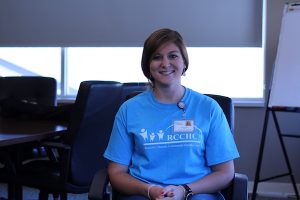The Carolina Heart Alliance Networking for Greater Equity (CHANGE) is testing an innovative program to encourage healthy habits and reduce the risk for heart disease by engaging community health workers (CHWs) to bridge the gap between clinical and community services.
Researchers from the UNC Center for Health Promotion and Disease Prevention (HPDP), a Prevention Research Center funded by the Centers for Disease Control and Prevention, have partnered with the local health department, federally qualified health center and community leaders to test this approach in Hertford County, NC for the CHANGE project. Hertford County is located in northeastern North Carolina, about 2.5 hours from the University of North Carolina at Chapel Hill. The area has an active farming community and other major employers include a privately run prison near the county seat of Winton and poultry processing plants. The community also has a strong public health infrastructure, including the Hertford County Public Health Authority, the Roanoke-Chowan Community Health Center and the North Carolina Area Health Education Center (AHEC).

The HPDP research team is led by Sam Cykert, MD, and Jennifer Leeman, DrPH. The CHANGE project builds on the PRC-developed Heart-to-Health intervention, which has been proven effective when delivered by clinicians, but hadn’t been tried with CHWs.
The research team chose Hertford County because of its rural and low-income population rural and low income and has high rates of unhealthy behaviors. They also chose Hertford because both Dr. Cykert and Dr. Leeman have worked with the community in the past and knew the Public Healthy Authority and Community Health Center would be great partners.
“RCCHC has been particularly good at reducing cardiovascular risk within the clinical realm,” said Cykert. “By connecting CHWs to the clinical world, it provides a great opportunity to reach into the community and not only improve health for those already at risk but to touch family members and others with lessons on diet and other heart healthy habits.”
After choosing Hertford County, the investigators sought out community leaders and public health practitioners to form a community advisory board to advise the process. They spent a year adapting the intervention and developing a plan for its implementation with the advisory team, and hired two community health workers in the fall of 2015.
Taylor Myers and Nikita Moore are both natives of Hertford County who have a keen interest in working in public health and helping their communities. Myers applied for the position after completing her undergraduate degree in health promotion, and said she was thrilled when she got the job.
“I was very excited, because prevention and intervention is what I always dreamed of doing,” said Myers. “Helping people to be more educated about health, especially around here, was very exciting. The most exciting part is being able to build a close relationship with a patient, because I can spend more time with them than a doctor or nurse might be able to.”
In addition to recruiting participants from the community, the project recruits through health care providers, and nurses and clinic staff provide potential participants information about the project. If the patient consents to follow-up, then Myers or Moore calls the patient to set up an initial appointment. Moore works with individuals who relay their interest through community organizations so her recruitment venues expands the primary prevention scope beyond the clinic and those who already have a diagnosis. Myers is based at the Roanoke-Chowan Community Health Center and Moore is based at the health department in nearby Winton.
“I always tell patients that I’m like the middle man between a nurse and a doctor,” said Myers. “I’m not a nurse and I’m not a doctor, and I have more time with my patients than a doctor; I’m allowed up to an hour and a half with them. That allows me to build a strong relationship with my patients.”
Myers has worked with 11 CHANGE participants who have completed the program. Those participants have said they enjoyed the program and have had good outcomes. The CHWs meet with participants four times throughout the program and take their blood pressure and health measurements at the beginning and end to see what changes have occurred.
She said that the partnerships built through CHANGE have helped to connect patients with resources in their communities, and that she felt those partnerships and relationships would last after the project is completed in 2019.
The next step for the project is to expand to a second community in 2017. The team will continue to use the CHW model and will be looking for CHWs in the new community to continue the work started in Hertford County.
The CHANGE project is the Applied Research Project of the UNC Prevention Research Center, based at HPDP. The Prevention Research Centers is a network of 26 academic research centers in 24 states that study how people and their communities can avoid or counter the risks for chronic illnesses, such as heart disease, obesity, and cancer. They identify gaps in research and develop innovative approaches to improving public health that can be shared broadly with public health partners. HPDP was one of the first three PRCs funded in 1986, and has been part of the PRC network for the entire 30 years of the program.
